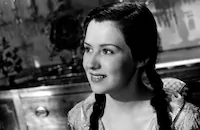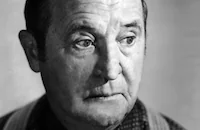Make Believe Ballroom
Cast & Crew
Joseph Santley
Jerome Courtland
Ruth Warrick
Ron Randell
Virginia Welles
Al Jarvis
Film Details
Technical Specs

Synopsis
Hoping to convince a group of reporters to write about a contest taking place at the radio station where she works, publicist Liza Lee relates the following story: A couple of weeks earlier, Liza is on the way to Ciro's, a Los Angeles nightclub, with popular disc jockey Al Jarvis, the host of the radio program "Make Believe Ballroom," when they both stop at a drive-in restaurant. Every week Josie Marlow, a high school student who works as a carhop, gives Jarvis a list of the musical numbers that are most popular with the other teenagers. Struck by the musical knowledge displayed by Josie and her fellow carhop, Gene Thomas, Liza gets an idea for a publicity contest. Each night for several weeks, Jarvis will play an unannounced song and the first person to guess the name of the artist will win a prize. At the end of the contest, the person who has won the most times will receive $5,000. The contest creates an intense rivalry between Josie and Gene, who have taken a dislike to each other. Josie wins the first night of the contest, but Gene wins the next and soon the two are tied for the lead. One night, George Wilcox, the owner of the drive-in, comes to eat there. He is angry when he learns that his customers are being ignored during the contest and forbids his employees to participate. When Liza, who has brought a photographer to the drive-in to shoot pictures of Josie and Gene, persuades Wilcox that the contest is free publicity for his restaurant, however, he changes his mind and allows Josie and Gene to continue to participate. Gene is the first weekly winner. In his radio interview, he compliments Josie, and when he later asks her to go for a drive with him, she agrees. Gene tells Josie that he intends to buy a rundown drive-in with the prize money and make it into a place for teenagers. Josie enthusiastically joins in his plans. Josie's chemistry teacher, Leslie Todd, is also romantically interested in her and asks Gene for dating advice. Josie overhears Gene talking and mistakenly believes that he no longer likes her. After Liza finishes her story, the reporters agree to visit the drive-in with her and speak to Gene and Josie. In the meantime, however, Wilcox has learned of Gene's plans to open a rival drive-in and fires him. Once again Liza intervenes, but Gene believes that Josie betrayed him to Wilcox and quarrels with her. After Gene forcefully rejects an offer from engineer Jerskin Elliott to fix the contest, Elliott falsely accuses Gene of attempting to bribe him, forcing Gene to drop out of the contest. Together with Liza, Josie hatches a plot to clear Gene's name, and he is allowed to compete for the final prize. Liza also tells Gene that Josie is in love with him, not with Leslie, and adds that she is engaged to Leslie herself. On the last day of the contest, Gene and Josie tie for first place and agree to share the money as partners in Gene and Josie's Drive-In.

Director

Joseph Santley
Cast

Jerome Courtland

Ruth Warrick

Ron Randell

Virginia Welles
Al Jarvis
Frankie Laine
King Cole Trio
Toni Harper
["smiling"] Jack Smith
Kay Starr
The Sportsmen
Charlie Barnet
Jimmy Dorsey
Jan Garber
Pee Wee Hunt
Gene Krupa
Ray Mckinley

Paul Harvey

Louis Jean Heydt

Frank Orth
Sid Tomack
Vernon Dent
Bob Mascagno
Allan Ray
Charleen Kerr
Sue Casey
Nancy Valentine
Dick Haynes
Don Otis
John Phillips
Ken Harvey
Peter Virgo

Pierre Watkin
Billy Snyder
Tiny Jimmy Kelly

Adele Jergens
Crew
Eddie Beal
Lew Brown
Nick Castle
M. Christiance
Harry J. Cole
Jack Corrick
James Crowe
Karen Dewolf
Albert Duffy
Albert Duffy
Dorothy Fields
Doris Fisher
Chet Forrest
Henry Freulich
George Handy
Al Jarvis
Herb Jeffries
Gene Krupa
Lester Lee
Jimmy Mchugh
Johnny Mercer
Gerry Mulligan
Paul Palmentola
Leon René
Ted Richmond
Allan Roberts
Jack Segal
Jerome Thoms
Albert Von Tilzer
Bob Wright

Film Details
Technical Specs

Articles
Make Believe Ballroom
Back in the early days of the medium, respectable stations hardly ever played records. Singers and bands most often performed live, and if someone wanted a copy of the music they just heard on the air, then they would go out and buy the recording. Two of the people who changed this practice were two of the earliest "disc jockeys" - Martin Block and Al Jarvis. New Yorker Block got his first job in radio after moving to the West Coast. He went to work for popular on-air host Jarvis, who by 1932 was already spinning discs on air during a segment of his show he called "The World's Biggest Make-Believe Ballroom." During this segment, Jarvis would play the records and describe for listeners the "scene" of the ballroom where a big band was supposedly playing.
When Block returned to New York after his brief stint in Los Angeles, he got a job at WNEW radio. In 1935 the station was offering coverage of the trial of Bruno Hauptmann for the kidnapping and murder of the infant son of aviator Charles Lindbergh. The station was able to carry only on-the-spot bulletins, and audience interest was so high, WNEW managers didn't want to schedule regular programming during the trial and miss reporting the latest developments. So Block came up with the idea of spinning records between bulletins. Station managers agreed, if Block could buy some records (WNEW owned none at the time) and find a sponsor (because no company was interested in paying for time to air records). The persistent Block purchased the necessary recordings, found his own sponsor (Retardo weight-loss pills), and response was enthusiastic. Block appropriated part of Jarvis's show's name, and within a few years "The Make-Believe Ballroom" had captured a fourth of the radio audience, a remarkable success that sealed the future of the medium. In fact, Block's program was so popular and influential that he is often credited as the originator of the idea while Jarvis is erroneously relegated to a footnote as an imitator who came along a few years later.
When this movie was released in 1949, however, Jarvis was still a popular and important on-air personality and he's the one who got the money for the film rights, the role of technical director, and screen time as the show host, although Block does appear uncredited as himself. (Block had come out West with much publicity and fanfare to take over the show in 1947, but Californians did not like his personality, and within a year he had returned to New York.) The storyline of Make Believe Ballroom follows two eager carhops (Jerome Courtland and Jarvis) as they compete for a $5000 prize in a name-that-song contest proposed to Jarvis by his fast-talking press agent Liza Lee (Ruth Warrick, who portrayed matriarch Phoebe Tyler on the TV soap opera All My Children from 1971 until her death in 2005). The two are friendly rivals until slick college professor Leslie Todd comes between them and frames Jerome for cheating.
Make Believe Ballroom features a number of top recording artists and radio stars of the day as themselves, including Nat King Cole, vocalists Frankie Laine and Kay Starr, and band leaders Charlie Barnet, Jimmy Dorsey, Jan Garber, and Gene Krupa. Barnet composed the first original theme of the show, titled "Make-Believe Ballroom," but Block later replaced it on the New York show with "It's Make-Believe Ballroom Time," a song composed by Glenn Miller with lyrics by Block himself. Although the Los Angeles show did not last much longer, the New York version lasted for decades under a string of hosts. Block was inducted into the Radio Hall of Fame in 1988, more than 20 years after his death.
Director Joseph Santley's only truly notable credit in his 30-year career, which was mostly in B movies, is The Cocoanuts (1929), the Marx Brothers' feature film debut. Early in his movie career he directed several short films featuring musical performances by such popular radio, concert and nightclub stars as Ruth Etting, Eddie Cantor, and Lillian Roth.
Director: Joseph Santley
Producer: Ted Richmond
Screenplay: Albert Duffy, Karen DeWolf
Cinematography: Henry Freulich
Editing: Jerome Thoms
Art Direction: Paul Palmentola
Cast: Jerome Courtland (Gene Thomas), Ruth Warrick (Liza Lee), Ron Randell (Leslie Todd), Virginia Welles (Josie Marlow).
BW-110m. Closed captioning
by Rob Nixon

Make Believe Ballroom
Quotes
Trivia
Notes
This film is loosely based on radio music programs broadcast by Martin Block in New York and Al Jarvis in Los Angeles. From 1935 to 1961 disc jockey Martin Block used the title for a radio program on WNEW in New York, which broadcast music from the mythical stage of The Make Believe Ballroom. A few years later, according to modern sources, Al Jarvis started a program with a similar format on KFWB in Los Angeles. In October 1945, Columbia purchased the screen rights to the Los Angeles radio show from Jarvis, according to a Hollywood Reporter news item, which also noted that Jarvis was to serve as technical advisor on the film. According to records in the copyright file, although the programs were similar in purpose and format, there was no connection between them. Make Believe Ballroom marked the motion picture debut of popular singer Frankie Laine (1913-2007).














